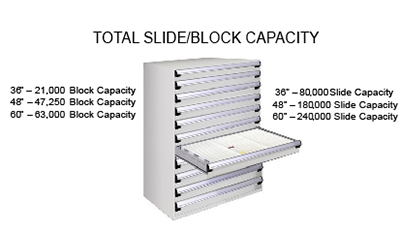In Part 1 of this series on hard storage systems, we discussed low volume options for the original pathologic sample items (raw tissue, tissue blocks/tissue slides) upon which the diagnosis was made. And how, with the need for legal liability, there is a need for this back-up storage resource. Electronic data systems can become corrupted, or they can be challenged, but hard storage items provide verifiable facts. In this article we continue that discussion, now considering larger volume systems that are typically considered for more permanent storage areas. These units are still mobile to some degree, but because of their heavier material (metal) and higher volume capacity, they are usually in a more fixed storage position and less transitional because of their weight.


The image to the right below, is an example of a denser, more permanently stationed unit constructed with an epoxy coated steel cabinet. This system is also a stackable modular system with multiple individual drawer designs to accommodate tissue block storage and microscopic tissue slide storage. This type of unit is designed with a permanent base stand, or as you can see in the small image, a special heavy duty wheeled stand, giving the user the option of permanent placement or the mobility to change storage locations.


With a greater need for volume in a storage system, you unfortunately sacrifice your options of mobility. The weight alone of a high-volume storage unit now presents another limitation that must be resolved. However, there are still options designed to address this restriction and allow the laboratory to efficiently utilize space. In Part 1 of this series, we discussed the more transitional, smaller storage options. Some such options were those made of durable corrugated cardboard that are extremely mobile. In a lab setting small quantities of these units can be kept on the bench and available for immediate retrieval. However, in hospital and/or reference type of laboratories where blocks/slides need to be frequently recalled, reviewed, or even re-sectioned, quick accessibility is needed. The accessibility of this many hard items may be problematic for labs and get in the way of day-to-day operations. In this case a viable option would be permanent shelving systems; not necessarily directly in the lab, but in a designated storage room where they can be retrieved. The image to the right illustrates a heavy-duty 11-gauge steel shelving system with 675 lb. weight capacity per shelf. Multiple individual storage units for blocks and/or slides can be stored on the shelves as well as formalin-filled or cytologic specimens. In this specific type of unit, you will note the center shelf has a retractable work shelf for organizing. These units can have add-on units as long as wall space and weight capacity in the room is adequate.

A final example of hard storage options are the high-density storage cabinets. This is the next generation of premium design and offers interchangeable full extension drawers, with a 400 lb. capacity per drawer. The system is designed with a non-tip safety feature that only allows one drawer to be open at a time, and a central locking device that ensures privacy and regulatory compliance. This type of system is so uniquely designed for the growing market that the units are custom built with the option of three different storage capacities. The text insert below shows the block and slide volumes for each cabinet size.

As you can see from the brief examples and information in these the articles, there are many options for you to consider, to minimize the unavoidable consequence of specimen hoarding. These can help keep your anatomic pathology lab a lean and organized environment.
References:
- Brown, S., ‘Histology Block & Slide Storage Options’, LabStore Highlights, 2020.
- Brown, S., “The Economy of Storage”, LabStore Highlights, 2021.
- Kapila, N., Boaz, K., Natarajan, S., “The Post-Analytical Phase of Histopathology Practice”, Int J Appl Basic Med Res, 2016.
- www.labstore.com.

